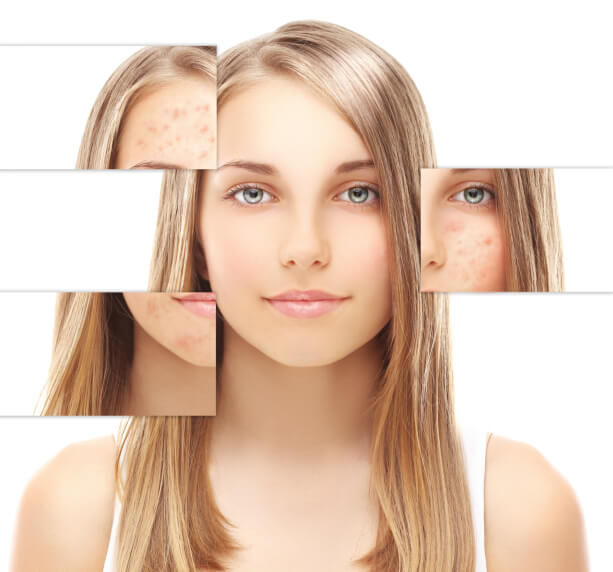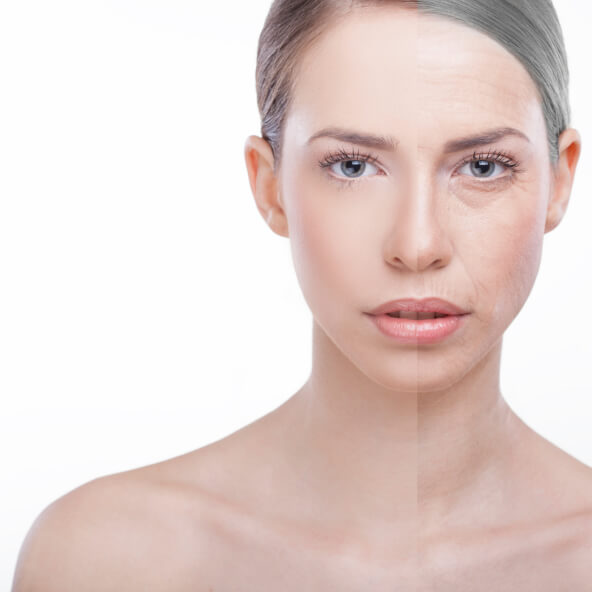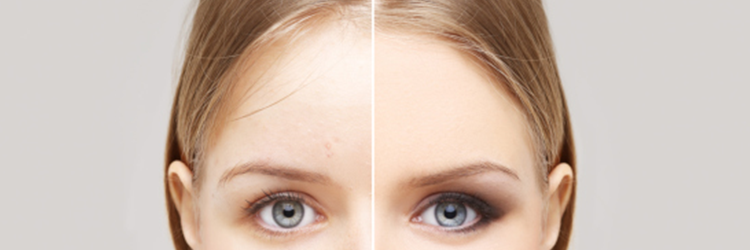Rosacea is a common inflammatory condition that typically manifests with pale skin and light eyes. The reported prevalence of Rosacea is between 0.5% and 10%.
Generally, Rosacea is expressed as flushing in patients in their 20s, which becomes bothersome to patients in their 30s, and may persist to advance thereafter. Rosacea occurring in the fourth and fifth decades of life is associated with morbidity.
Rosacea also affects children but generally remains unnoticed as the tendency of flushing and erythema is mistaken as “healthy glow” in children. There are chances that in paediatric patients having a family history of Rosacea, the disorder may exist and advance into adulthood.
Signs and symptoms
Subtype 1: Facial redness, flushing and visible blood vessels
- Flushing and redness appear in the centre of the face;
- Observable broken blood vessels (spider veins);
- Skin appears dry, rough or with scaling;
- Skin may be extremely sensitive;
- Skin swollen;
- Skin burning and stinging;
- Tendency to flush or blush more easily as compared to other people.
Subtype 2: Acne-like breakouts
- Acne-like breakouts generally occur where the skin is quite red;
- Appearing and disappearing tendency of Acne-like breakouts;
- Skin may be extremely sensitive;
- Skin is oily;
- Appearance of broken blood vessels (spider veins);
- Skin burning and stinging;
- Visible raised skin patches known as plaques (plaks).

This subtype is uncommon. When this subtype occurs, the patient usually initially presents with signs and symptoms of another subtype of rosacea.
Signs of this subtype are:
- Rough texture of the skin;
- Appearance of visible broken blood vessels;
- Thickening of skin particularly on the nose. Thickening of skin on the nose is known as rhinophyma;
- Oily skin ;
- Thickening of the skin may appear on the forehead, ears, chin and cheeks;
- Appearance of large pores.
Subtype 4: In the eyes

- Watery or bloodshot eyes;
- Burning or stinging in the eyes;
- Gritty sensation, which feels like sand in the eyes;
- Itching in the eyes;
- Dry eyes;
- Blurred vision;
- Cyst on the eyelid;
- Eyes intolerant to light;
- Broken blood vessels noticed on the eyelid;
- Disturbed vision.
Causes of Rosacea
The exact causative factor for rosacea is not known, though several probable factors have been identified. There are chances that a combination of these factors may give rise to rosacea but there is no sufficient data to confirm this conclusion.
Probable Factors
- Blood vessel abnormalities – There is a belief that blood vessel abnormalities of the face may be responsible for this condition. Blood vessel abnormalities give rise to symptoms such as flushing, constant redness and noticeable blood vessels.
- Skin peptides – Recent research has claimed external triggers namely spicy food, exercise, ultraviolet (UV) light, cold, alcohol, red wine, stress and heat can give rise to the activation of some molecules within the skin known as peptides. The neurovascular system (nerves and blood vessels) of the skin is affected by the increased levels of skin peptides. Inflammation, redness and dilation of blood vessels are caused due to the activation of the neurovascular system of the skin.
- Genetics – This condition appears to be more frequent in families though the type of gene (if any) concerned and the passage of the gene is unclear.
Triggers of rosacea
The below mentioned triggers are not direct causes of rosacea but these may worsen symptoms in several people suffering from rosacea. The type of trigger differs from person to person.
Few triggers that have been commonly noticed are:
- Alcoholic drinks;
- Humidity;
- Menopause in females;
- Stress;
- Sunlight exposure;
- Spicy foods;
- Caffeine present in cola, tea and coffee;
- Hot baths;
- Strong winds;
- Dairy products;
- Cold or hot weather;
- Certain medications namely corticosteroids, amiodarone and large doses of vitamins B6 and B12;
- Exercise;
- Hot drinks;
- Certain medical conditions.
Treatment Plan
Modern medical treatment plan for rosacea aims at decreasing the intensity and number of inflammatory lesions and at reducing erythema with the help of both systemic and topical agents.
1) Oral agents
The only oral agent approved by the FDA for the treatment of rosacea is anti-inflammatory dose doxycycline (40-mg delayed-release capsule prescribed once in a day).
Based on prevalent case reports, studies and clinical experiences, a number of oral antibiotics have been used off-label in the treatment of rosacea.
2) Topical agents
Selection of topical agents for the treatment of rosacea is dependent on several criteria namely:
- Efficacy and tolerability;
- Skin type of patient;
- Mechanism of action and
- Response to previous treatment.
Three topical therapies approved by the Food and Drug Administration (FDA) for rosacea are:
- Azelaic acid (AzA) 15% gel;
- Metronidazole and
- Sulfacetamide 10%/sulfur 5% (sulfacetamide/sulfur).
Combination Therapies
Rosacea is effectively treated with the help of topical metronidazole and systemic antibiotics having anti-inflammatory activity. In cases of mild-to-moderate rosacea, an anti-inflammatory dose of doxycycline along with topical metronidazole gel 1% seems to be beneficial in decreasing the number of inflammatory lesions and is well accepted.
Phototherapy
Quite a few reports have established light-based treatments to be beneficial in the management of erythema observed in rosacea patients. Intense pulsed light (IPL) at a wavelength of 550 to 670 nm may be helpful for treating rosacea.
Non medical Therapies
Doctors usually advise patients suffering with rosacea to:-
- Use sun-screens regularly;
- Adopt a basic skin care regimen;
- Proper use of concealing makeup and
- Regular follow-up of any optical symptoms.
Non-medical therapies offer noteworthy benefits. They help in improving the roughness, dryness and desquamation of the skin. They also help reduce considerably the sensitivity of the skin and therefore improve skin comfort.















